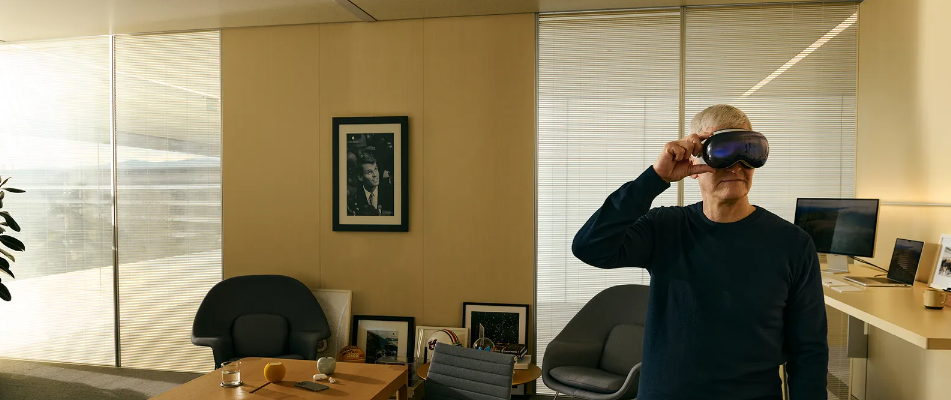Why Tim Cook Is Going All In on the Apple Vision Pro
The first time Tim Cook experienced the Apple Vision Pro, it wasn’t called the Apple Vision Pro. It was years ago; maybe six, seven, or even eight.
Apple Park
Before the company built Apple Park, where we’re sitting right now, at a bleached oak table in this incredible circular edifice of a building clad in miles of curved glass. It’s been raining, and the clouds are clearing over the pine trees and the rows of citrus and maple trees, and the sun is reflecting off the pond in the meadow, and it’s kind of mesmerizing. And Cook’s telling me about that time, all those years ago, in his dulcet Robertsdale, Alabama, accent, when he first saw it.
Black Ops
It was at Mariani 1, a nondescript low-rise building on the edge of the old Infinite Loop campus with blacked-out windows. This place is so secret, it’s known as one of Apple’s “black ops” facilities. Nearly all of the thousands of employees who work at Apple have never set foot inside one. There are multiple layers of doors that lock behind and in front of you. But Cook is the CEO and can go anywhere. So he strolls past restricted rooms where foldable iPhones and MacBooks with retractable keyboards or transparent televisions were dreamed up. Where these devices, almost all of which will never leave this building, are stored in locked Pelican cases inside locked cupboards.
This building, after all, is folklore to Apple. It’s where the iPod and the iPhone were invented. This same building, where Cook finds the industrial design team working on this thing virtually no one else knows exists. Mike Rockwell, vice president of Apple’s Vision Products Group, is there when Cook enters and sees it. It’s like a “monster,” Cook tells me. “An apparatus.” Cook’s told to take a seat, and this massive, monstrous machine is placed around his face. It’s crude, like a giant box, and it’s got screens in it, half a dozen of them layered on top of each other, and cameras sticking out like whiskers. “You weren’t really wearing it at that time,” he tells me. “It wasn’t wearable by any means of the imagination.” And it’s whirring, with big fans—a steady, deep humming sound—on both sides of his face. And this apparatus has these wires coming out of it that sinuate all over the floor and stretch into another room, where they’re connected to a supercomputer, and then buttons are pressed and lights go on and the CPU and GPU start pulsating at billions of cycles per second and…Tim Cook is on the moon!
He’s sitting right there. On the fucking moon! With Buzz Aldrin and Neil Armstrong of Apollo 11, he looks around and there’s the ghostly luminescence of ancient dust under a black, star-studded sky. It’s magnificent. It’s amazing. There, in the distance, is the earth. The blue dot. Where all of this magic is happening.
Magic
But Cook’s not just on the moon. He’s also in that secret room. In that secret building. And he can see Rockwell and other Apple employees, and he can see his own hands. And he knows right then and there what this all means. Like the universe is telling him something. He knows that this is the future of computing and entertainment and apps and memories, and that this crude apparatus wrapped around his head will change everything. He knows Apple has to make this thing its next product category.
About E. J. McKay
E.J.McKay is a Shanghai-headquartered investment bank with a special focus on mergers & acquisitions. We are one of the most long standing independent investment banks in China, with core business of mergers & acquisitions and financing advisory.


